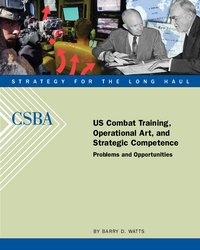
Starting with the establishment of the US Navy’s Fighter Weapons School (Topgun) in late 1968, the American military Services began committing themselves to longterm, sustained investments in realistic combat training despite the considerable costs and risks. The idea was to train fighter crews and, later, members of armored or mechanized units and other combatants in environments that closely replicated the challenges and stresses of actual combat. The insight behind this American “revolution in training affairs” was that, in the past, most individual losses had occurred during early missions or engagements when combatants were inexperienced novices prone to costly mistakes. The hope was that realistic training could enable most individuals to acquire the proficiency that only the survivors of early combat encounters had previously gained, whether by luck or innate talent. The US Air Force’s Red Flag exercises, the US Army’s National Training Center, and the US Marine Corps Air Ground Combat Center are concrete manifestations of this commitment to tactical proficiency.
Free-play tactical training in which large numbers of opposing combat aircraft or armored fighting vehicles maneuver against one another in mock engagements and battles initially increased the risks of “avoidable” training accidents. At the same time, building and sustaining large, instrumented range complexes in which such training could be conducted, live ordnance expended, and individual performance objectively evaluated was also expensive. Nevertheless, after the Vietnam War the US military Services accepted these risks and infrastructure costs.



























